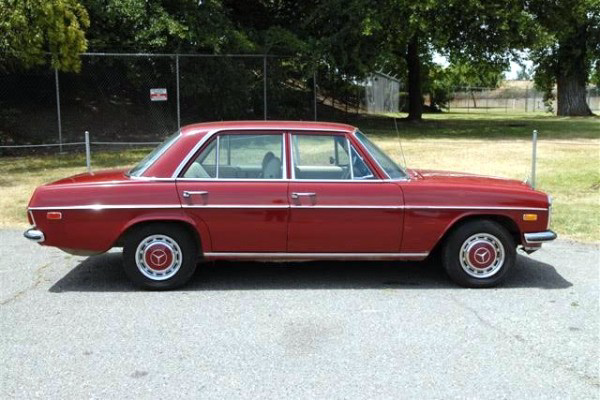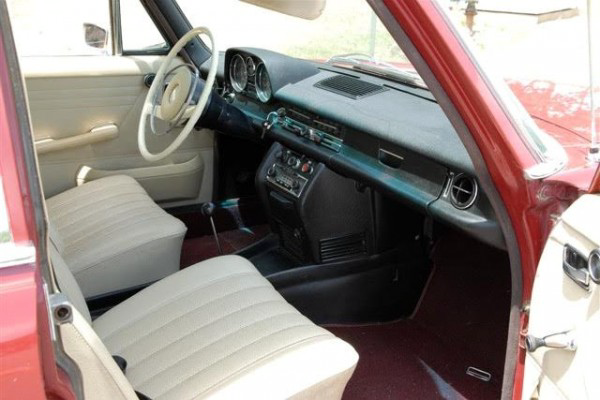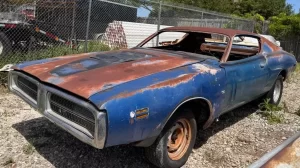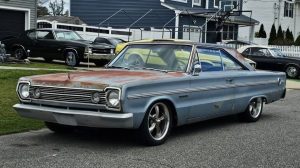This Mercedes 230 has quite the story. It was stored in the owner’s garage for at least 10 years and has has only about 46,000 miles on it. The paint and interior are all original and look almost new. The family purchased it new in Germany and have owned it since. There are a few rust spots along the bottom of the body. The engine starts, but there is no compression in the #5 cylinder, possibly a stuck valve? The gas has turned to varnish, of course, so the carburetors will need to be rebuilt and the gas tank and lines flushed out. There is a crack in the windshield. There are some light scratches on the right front fender, but is otherwise quite a beautiful find! The museum I volunteer at purchased it and will be going through it before it goes to market. I just thought you guys might like to see it!
Auctions Ending Soon
 1969 Ford Mustang Mach 1 Cobra JetBid Now1 days$35,500
1969 Ford Mustang Mach 1 Cobra JetBid Now1 days$35,500
 1990 Ford Mustang 7UP EditionBid Now1 days$8,000
1990 Ford Mustang 7UP EditionBid Now1 days$8,000
 1952 Dodge B-3-BBid Now1 days$3,000
1952 Dodge B-3-BBid Now1 days$3,000
 1970 Ford Torino GT ConvertibleBid Now2 days$18,500
1970 Ford Torino GT ConvertibleBid Now2 days$18,500
 1968 Ford Ranger F-250 4x4Bid Now5 days$7,500
1968 Ford Ranger F-250 4x4Bid Now5 days$7,500
Disclosure: This site may receive compensation when you click on some links and make purchases.
Jun 7, 2015 • For Sale • 17 Comments
1969 Mercedes 230: Garage Survivor
Get Daily Email Updates:
Click here for more options







That is no 63……….maby a 66 to a 73
Hmm, seems to be a early or mid 70’s Benz. Early steering wheel, though. What chassis is that car?
More pics please?
This car is most likely a 68 or 69. Clues:
The 230 6 cylinder was the leftover engine (M180) from the final era, with 4 main bearings, as opposed to the more modern 250 with 7 main bearings, which was found in most later W114 cars. Few 230s were sold after 1969.
The early style steering wheel and upholstery pattern, the single mirror, early emergency switch, etc.
There was a later model 230 in the big bumper era (74 to 76) but it was a 4 cylinder.
I have a 69 model 230 like this one that I rescued from becoming a parts car. They are comfortable to tool around in – a nice size, 4 wheel power disc brakes, decent handling – however most have a 4.08 rear gear ratio, which leads to high, noisy revs on the Interstate. This can be remedied by changing out the center differential to a later 3.69 or 3.27 ratio.
Also, the standard twin Zenith carburetor setup is tricky to tune.
These W114 / W115 series cars are under appreciated and under valued in today’s market, compared to other similar vehicles of the era which ride like old trucks in comparison.
This car is most likely a 68 or 69. Clues:
The 230 6 cylinder was the leftover engine (M180) from the final era, with 4 main bearings, as opposed to the more modern 250 with 7 main bearings, which was found in most later W114 cars. Few 230s were sold after 1969.
The early style steering wheel and upholstery pattern, the single mirror, early emergency switch, etc.
There was a later model 230 in the big bumper era (74 to 76) but it was a 4 cylinder.
I have a 69 model 230 like this one that I rescued from becoming a parts car. They are comfortable to tool around in – a nice size, 4 wheel power disc brakes, decent handling – however most have a 4.08 rear gear ratio, which leads to high, noisy revs on the Interstate. This can be remedied by changing out the center differential to a later 3.69 or 3.27 ratio.
Also, the standard twin Zenith carburetor setup is tricky to tune.
These W114 / W115 series cars are under appreciated and under valued in today’s market, compared to other similar vehicles of the era which ride like old trucks in comparison.
The marker lights tell me it’s a 68 or newer. I do like it. Probably an early 70s car.
This body style came out in 1968.
The 230 was either 6 cylinder (early cars, 1968-72 ) or 4 cylinder (late, 1973-76).
The small bumpers combined with the marker lights tell me it’s a US model before 1973.
If it’s a Euro car they all had small bumpers and the marker lights DO look a little off (location) and all bets are off.
Mileage would be in K-meters not miles.
Odometers had 5 digits, so take your best guess at the mileage, no telling how many……
Interior looks good.
these usually rusted without inhibition, so check this thoroughly, especially if the paint looks new(er).
Sixes motors were pretty much indestructible, unless neglected, the fours were iffy, and chocked by smog-stuff.
A sunroof would be a HUGE benefit or else you have a pretty usual run of the mill old Mercedes.
I guess it beats a Camry any day of the week.
A museum flipping cars ?, that’s a new one !!
The California Automobile Museum is totally self supporting. We rely on admissions, of course, as well as renting our facilities for special events (tonight we have a graduating high school class in for an all nighter) and such. We find cars, often barn finds, that the owners have quit using and sell them for the owner on consignment. Some cars are donated. We do not purchase cars to sell at a profit, so, no, we’re not flipping cars. We find homes for neglected cars. We sell them mostly as is except for getting them smoged and in the case of donated cars, volunteers clean them up a bit and perhaps check the state of the mechanicals. Her is the link to our website; http://www.calautomuseum.org/ and to our auto sales page http://www.camcarsales.com/inventory.aspx
# 5 low compression, I have a little knowledge on this subject. The six cylinder used in the 230/250 had a problem with the casting on the number 5 cylinder, The water passage was very close to the cylinder itself and we would see the gasket most of the time blow out or the head would crack thus expensive repair. It seems it was only on this cylinder
More pictures are here; http://www.camcarsales.com/1969_MercedesBenz_230_Sacramento_CA_255961643.veh
It’s also listed on eBay here; http://www.ebay.com/itm/331575419528?
This car was purchased from a dealer in the US in 1969. The owners picked it up at the Mercedes factory. It is a US spec Mercedes with the speedometer in miles. The import paperwork is with the car.
(It would be nice if it was a sunroof car. My 1966 has a sunroof and I love the sunroof!)
I bought a new 250 MB in 1969, 4 speed stick, Tobacco brown/Parchment interior. Great car, the 250 had the newer/bigger engine, and it had double front bumpers. Wish I still had it.
I own a 1972 Mercedes 250 that’s been in the family since new. It is a very comfortable car to drive. It’s an all original survivor with about 135,000 miles on it. The only alteration I’ve made to the car is the replacement of the Zenith carbs with a set of Webers sold as a kit for installation on a Mercedes. Amazing what a difference these carbs make on the smoothness and acceleration of this car.
Why are the “6”s in the odometer so skinny?
Completely a guess, but Mercedes would think of details like that !!
Design to differentiate from the 8’s and 9’s maybe even 3’s in low light….
lots of people wondering about the skinny 6s
http://www.sl113.org/forums/index.php?topic=9279.0
reply #30 seems to have the final answer.
JASON – the [ 6 ] is so skinny because it needed to clear the gear assembly.
All the MB of this era have this same speedo head.
Looks nice. We pulled a 71 220 that a relative owned for years out of his barn in December. It was parked in 2003 for reasons unknown. Proved to have head and timing chain issues. Son revived it for high school senior project. Ours looked similar for body condition but we’ve found a lot of West Virginia tin worm issues hiding under the old undercoating. A pleasant roomy car now that it’s running.
Great looking car ! Love the colour and the interior.